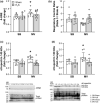Hydrogen sulfide donor protects against mechanical ventilation-induced atrophy and contractile dysfunction in the rat diaphragm
- PMID: 34080307
- PMCID: PMC8604213
- DOI: 10.1111/cts.13081
Hydrogen sulfide donor protects against mechanical ventilation-induced atrophy and contractile dysfunction in the rat diaphragm
Abstract
Mechanical ventilation (MV) is a clinical tool providing adequate alveolar ventilation in patients that require respiratory support. Although a life-saving intervention for critically ill patients, prolonged MV results in the rapid development of inspiratory muscle weakness due to both diaphragmatic atrophy and contractile dysfunction; collectively known as "ventilator-induced diaphragm dysfunction" (VIDD). VIDD is a severe clinical problem because diaphragmatic weakness is a risk factor for difficulties in weaning patients from MV. Currently, no standard treatment to prevent VIDD exists. Nonetheless, growing evidence reveals that hydrogen sulfide (H2 S) possesses cytoprotective properties capable of protecting skeletal muscles against several hallmarks of VIDD, including oxidative damage, accelerated proteolysis, and mitochondrial damage. Therefore, we used an established animal model of MV to test the hypothesis that treatment with sodium sulfide (H2 S donor) will defend against VIDD. Our results confirm that sodium sulfide was sufficient to protect the diaphragm against both MV-induced fiber atrophy and contractile dysfunction. H2 S prevents MV-induced damage to diaphragmatic mitochondria as evidenced by protection against mitochondrial uncoupling. Moreover, treatment with sodium sulfide prevented the MV-induced activation of the proteases, calpain, and caspase-3 in the diaphragm. Taken together, these results support the hypothesis that treatment with a H2 S donor protects the diaphragm against VIDD. These outcomes provide the first evidence that H2 S has therapeutic potential to protect against MV-induced diaphragm weakness and to reduce difficulties in weaning patients from the ventilator. Study Highlights WHAT IS THE CURRENT KNOWLEDGE ON THE TOPIC? Mechanical ventilation (MV) results in diaphragm atrophy and contractile dysfunction, known as ventilator-induced diaphragm dysfunction (VIDD). VIDD is important because diaphragm weakness is a risk factor for problems in weaning patients from MV. Currently, no accepted treatment exists to protect against VIDD. Growing evidence reveals that hydrogen sulfide (H2 S) donors protect skeletal muscle against ischemia-reperfusion-induced injury. Nonetheless, it is unknown if treatment with a H2 S donor can protect against VIDD. WHAT QUESTION DID THIS STUDY ADDRESS? Can treatment with an H2 S donor protect against VIDD? WHAT DOES THIS STUDY ADD TO OUR KNOWLEDGE? This study provides the first evidence that treatment with a H2 S donor protects against VIDD. HOW MIGHT THIS CHANGE CLINICAL PHARMACOLOGY OR TRANSLATIONAL SCIENCE? These new findings provide the basis for further exploration of H2 S donors as a therapy to prevent VIDD and reduce the risk of problems in weaning patients from MV.
© 2021 The Authors. Clinical and Translational Science published by Wiley Periodicals LLC on behalf of American Society for Clinical Pharmacology and Therapeutics.
Conflict of interest statement
The authors declared no competing interests for this work.
Figures


Similar articles
-
Angiotensin 1-7 protects against ventilator-induced diaphragm dysfunction.Clin Transl Sci. 2021 Jul;14(4):1512-1523. doi: 10.1111/cts.13015. Epub 2021 May 1. Clin Transl Sci. 2021. PMID: 33742769 Free PMC article.
-
Comparative Efficacy of Angiotensin II Type 1 Receptor Blockers Against Ventilator-Induced Diaphragm Dysfunction in Rats.Clin Transl Sci. 2021 Mar;14(2):481-486. doi: 10.1111/cts.12916. Epub 2020 Nov 22. Clin Transl Sci. 2021. PMID: 33222389 Free PMC article.
-
Increased SOD2 in the diaphragm contributes to exercise-induced protection against ventilator-induced diaphragm dysfunction.Redox Biol. 2019 Jan;20:402-413. doi: 10.1016/j.redox.2018.10.005. Epub 2018 Oct 21. Redox Biol. 2019. PMID: 30414534 Free PMC article.
-
Ventilator-induced diaphragm dysfunction: phenomenology and mechanism(s) of pathogenesis.J Physiol. 2024 Oct;602(19):4729-4752. doi: 10.1113/JP283860. Epub 2024 Aug 31. J Physiol. 2024. PMID: 39216087 Review.
-
Ventilator-induced diaphragm dysfunction: cause and effect.Am J Physiol Regul Integr Comp Physiol. 2013 Sep;305(5):R464-77. doi: 10.1152/ajpregu.00231.2013. Epub 2013 Jul 10. Am J Physiol Regul Integr Comp Physiol. 2013. PMID: 23842681 Review.
Cited by
-
Targeting Hydrogen Sulfide Modulates Dexamethasone-Induced Muscle Atrophy and Microvascular Rarefaction, through Inhibition of NOX4 and Induction of MGF, M2 Macrophages and Endothelial Progenitors.Cells. 2022 Aug 11;11(16):2500. doi: 10.3390/cells11162500. Cells. 2022. PMID: 36010575 Free PMC article.
-
Cellular senescence contributes to mechanical ventilation-induced diaphragm dysfunction by upregulating p53 signalling pathways.BMC Pulm Med. 2023 Dec 14;23(1):509. doi: 10.1186/s12890-023-02662-7. BMC Pulm Med. 2023. PMID: 38097957 Free PMC article.
-
Aldh1a1 and Scl25a30 in diaphragmatic dysfunction.Exp Biol Med (Maywood). 2022 Jun;247(12):1013-1029. doi: 10.1177/15353702221085201. Epub 2022 Apr 11. Exp Biol Med (Maywood). 2022. PMID: 35410502 Free PMC article.
-
Utility of NO and H2S donating platforms in managing COVID-19: Rationale and promise.Nitric Oxide. 2022 Nov 1;128:72-102. doi: 10.1016/j.niox.2022.08.003. Epub 2022 Aug 24. Nitric Oxide. 2022. PMID: 36029975 Free PMC article. Review.
-
Identification of key genes affecting ventilator-induced diaphragmatic dysfunction in diabetic mice.Front Genet. 2024 May 9;15:1387688. doi: 10.3389/fgene.2024.1387688. eCollection 2024. Front Genet. 2024. PMID: 38784031 Free PMC article.
References
-
- Vassilakopoulos T, Petrof BJ. Ventilator‐induced diaphragmatic dysfunction. Am J Respir Crit Care Med. 2004;169:336‐341. - PubMed
-
- Kim WY, Suh HJ, Hong SB, Koh Y, Lim CM. Diaphragm dysfunction assessed by ultrasonography: influence on weaning from mechanical ventilation. Crit Care Med. 2011;39:2627‐2630. - PubMed
-
- Beduneau G, Pham T, Schortgen F, et al. Epidemiology of weaning outcome according to a new definition. The WIND study. Am J Respir Crit Care Med. 2017;195:772‐783. - PubMed
-
- Powers SK, Wiggs MP, Sollanek KJ, Smuder AJ. Ventilator‐induced diaphragm dysfunction: cause and effect. Am J Physiol Regul Integr Comp Physiol. 2013;305:R464‐R477. - PubMed
Publication types
MeSH terms
Substances
Grants and funding
LinkOut - more resources
Full Text Sources
Research Materials
Miscellaneous

